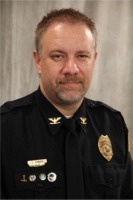 Jamestown (CSi) Jamestown Police Chief Edinger reports that Officer Logan Hord of the Jamestown Police Department, assigned to the Stutsman County Narcotics Task Force, and Deputies Daniel White and Casey Yunck of the Stutsman County Sheriff’s Office have returned to duty.
Jamestown (CSi) Jamestown Police Chief Edinger reports that Officer Logan Hord of the Jamestown Police Department, assigned to the Stutsman County Narcotics Task Force, and Deputies Daniel White and Casey Yunck of the Stutsman County Sheriff’s Office have returned to duty.
No charge is warranted for any law enforcement officer involved.
The individuals were involved the shooting on Wednesday February 21st
He says the Jamestown Police Department and the Stutsman County Sheriff’s Office conducts its own internal investigation into the incident.
The items covered include: if policies and procedures were followed, and if appropriate use of force was applied.
He adds that the North Dakota Bureau of Criminal Investigation is handling the criminal investigation.
Chief Edinger pointed out that each of the officers and deputies involved in such a shooting are typically placed on paid administrative leave while the investigation is on-going and pending the results.
Previously…
Stutsman County Sheriff Chad Kaiser released the name of a Jamestown man, who died following a high speed pursuit on Wednesday this week, in a gun confrontation with law enforcement north of Medina.
He reports that 27 year old Michael Andrew Schieffer, last known to be from Jamestown, died following the incident.
Kaiser says the City of Bismarck issued a warrant for Schieffer for driving under suspension. A Jamestown police officer attempted to pull him over while driving his vehicle, around 11:38 a.m. in the 1900 block of 12th Avenue Northeast, and the pursuit followed.
MEMORANDUM
to: Special Agent Kelly Wimer, ND Bureau of Criminal Investigation, kw430@nd.gov
Chief Scott Edinger, Jamestown Police Department, sedinger@nd.gov
Sheriff Chad Kaiser, Stutsman County Sheriff’s Office, chkaiser@nd.gov
from: Fritz Fremgen, State’s Attorney, Stutsman County
511 2nd Ave SE, Jamestown, ND 58401
Office: 252-6688, ffremgen@nd.gov
subject: officer involved shooting, BCI 18-107
date: March 16, 2018
Reports from North Dakota Bureau of Criminal Investigation Special Agent Kelly Wimer were sent to the Stutsman County State’s Attorney for review.
This is a tragic situation. Law enforcement used restraint and self-control balancing the execution of their duty with preserving everyone’s safety.
The issue is whether the law enforcement officers who followed Schieffer to execute an arrest warrant and to try to make an arrest for DUS and fleeing or attempting to elude, and eventually
fired at Schieffer ought to be criminally charged.
A Jamestown Police Department officer saw Schieffer driving, knew Schieffer’s driver’s license had been suspended recently, called dispatch, confirmed Schieffer’s license was suspended, and
attempted to initiate a traffic stop. Schieffer did not stop. The officer also asked whether there were any warrants for Schieffer’s arrest and dispatch informed the officer there was a warrant.
Jamestown Police Department followed Schieffer out of town but eventually discontinued the pursuit due in part to the speed involved and the distance from town.
Stutsman County Sheriff’s deputies and ND Highway Patrol picked up the attempt to apprehend Schieffer.
On the 21st of February 2018, the day of the shooting, Schieffer was on the phone with his friend K. Interviewed after the shooting, K told the BCI investigator that K returned a message from Schieffer and had a voice conversation with Schieffer over the phone. K said that during the
voice conversation K could hear sirens in the background, Schieffer sounded frantic, and that Schieffer told K that Schieffer was in a high speed chase in Jamestown, was not going back to prison, had a firearm, and had shot at the police in an attempt to get the police to shoot him. K indicated to the investigator that K told Schieffer to pull over, put his hands up, and tell the
police he had a gun.
A law enforcement officer interviewed in regard to the pursuit reported that Schieffer held a handgun outside the window of Schieffer’s moving vehicle and fired two rounds at the pursuing law enforcement officer. The deputy reported hearing the report of Schieffer’s handgun over the
sirens. The deputy reported he felt that Schieffer was trying to kill him. The deputy reported giving Schieffer about a ½ mile of space. Rounding another corner, the deputy reported Schieffer again put the gun outside Schieffer’s window and appeared to discharge another two rounds.
The deputy reported Schieffer drove into a snow drift and got stuck.
The deputy stopped about a ½ mile from Schieffer’s stuck vehicle and stood behind the tail gate of his patrol vehicle using binoculars to observe Schieffer. The deputy saw Schieffer had a cell phone in one hand and a pistol in the other.
Schieffer walked towards the parked officers sometimes circling but generally continuing his advance towards the officers. One law enforcement officer used a public address system and others yelled at Schieffer pleading with Schieffer and commanding Schieffer to put his gun down
and stop advancing toward the officers. This was going on when Schieffer was about 200 yards from the officers. Schieffer was seen putting the pistol to Schieffer’s own head as well as bringing the gun up possibly at officers. Schieffer responded to the officers’ requests by saying “Shut the f*** up, I’m trying to talk.” It is clear Schieffer heard and considered the pleading of
the officers. The officers warned Schieffer that if he continued to advance he would be shot.
Schieffer continued to move toward the officers.
Officers conferred and determined a landmark beyond which it was unsafe to allow Schieffer.
As Schieffer approached the landmark, officers screamed at Schieffer to drop his gun. A deputy felt that Schieffer was going to do something and Schieffer said something unintelligible
immediately after which Schieffer brought his gun up and shot a round. The deputy reported he returned fire at Schieffer. Other law enforcement officers also fired on Schieffer. Officers discussed whether to rush in and administer aid to Schieffer or wait for back up. They chose to wait and gave first aid after back up arrived and until medical treatment providers arrived.
Generally, in making an arrest, an officer is under no obligation to retreat but has the legal right to press forward to accomplish the arrest. State v. Washington, 2007 ND 138, ¶16, 737 N.W.2d
382, 389.
As Schieffer approached the officers from a half mile away with a handgun and when Schieffer raised the handgun; there was probable cause to believe Schieffer had committed the felony
offense of terrorizing. When Schieffer fired at the officers, there was probable cause that Schieffer had committed several other felonies.
A law enforcement officer is justified in using deadly force to effect an arrest or prevent the escape from custody of an individual who has committed or attempted to commit a felony involving violence, or is attempting to escape by the use of a deadly weapon, or has otherwise
indicated that the individual is likely to endanger human life or to inflict serious bodily injury unless apprehended. NDCC § 12.1-05-07(2)(d); Tennessee v. Garner, 471 U.S. 1, 11-12, 105
S.Ct. 1694, 1701, 85 L.Ed.2d 1 (1985); Smith v. Freland, 954 F.2d 343 (6th Cir. 1992); Sanders v. City of Minneapolis, 474 F.3d 523 (8th Cir. 2007); Whitaker v. Pima County, 640 F. Supp. 2d 1095 (D. Ariz. 2009); Ridgeway v. City of Woolwich , 924 F. Supp. 653 (D. N.J. 1996);
Annotation, Right of Police Officer to Use Deadly Force in Attempting to Arrest . . . 83 A.L.R.3d
174.
Schieffer had committed a felony involving violence and the officers were justified in using deadly force to effectuate Schieffer’s arrest.
Besides the licensed peace officer’s power to arrest, every North Dakotan has the right to defend himself from imminent unlawful bodily injury. NDCC § 12.1-05-03. Additionally, a person is justified in using force upon another person to defend anyone else if the person defended would be justified in defending himself and the person coming to the defense has not by provocation or otherwise forfeited the right of self-defense. NDCC § 12.1-05-04. The law enforcement officers legitimately exercised the right to defend themselves and each other.
No charge is warranted for any law enforcement officer involved












Comments are closed
Sorry, but you cannot leave a comment for this post.